Samoa - Silver Piedfort
1984 Piedfort Proof Silver Tala 38.8mm (30.40 grams) 0.925 Silver (0.9041 oz. ASW)
Reference: KM# P1
Certification: NGC
PF 69 ULTRA CAMEO 2863757-010
MALETOA TANUMAFILI II SAMOA I SISIFO, Malietoa facing left.
1984 FA'AVAE ILE ATUA SAMOA $ 1, National arms (Wreathed shield, stars and palm on waters within.) You are bidding on the exact item pictured, provided with a Certificate of Authenticity and Lifetime Guarantee of Authenticity.
 Malietoa Tanumafili II (4 January 1913 - 11 May 2007), addressed Susuga Malietoa Tanumafili II, was the Malietoa, the title of one of Samoa's four paramount chiefs, and the head of state, or O le Ao o le Malo, a position that he held for life, of Samoa from 1962 to 2007. He was co-head of state in 1962 with the tama-a-'aiga Tupua Tamasese Mea'ole and became the sole head of state on 15 April 1963 upon the death of his counterpart. At the time of his death, he was the oldest national leader in the world, and was also the last incumbent president-for-life in the world. Malietoa Tanumafili II (4 January 1913 - 11 May 2007), addressed Susuga Malietoa Tanumafili II, was the Malietoa, the title of one of Samoa's four paramount chiefs, and the head of state, or O le Ao o le Malo, a position that he held for life, of Samoa from 1962 to 2007. He was co-head of state in 1962 with the tama-a-'aiga Tupua Tamasese Mea'ole and became the sole head of state on 15 April 1963 upon the death of his counterpart. At the time of his death, he was the oldest national leader in the world, and was also the last incumbent president-for-life in the world.
The Malietoa is one of the four tama-a-'aiga (maximal lineage titles) of Samoa, alongside Tupua Tamasese, Mata-afa and Tuimalealiifano.
Midnight Ride
When British Army activity on April 7, 1775, suggested the possibility of troop movements, Joseph Warren sent Revere to warn the Massachusetts Provincial Congress, then sitting in Concord, the site of one of the larger caches of Patriot military supplies. After receiving the warning, Concord residents began moving the military supplies away from the town. One week later, on April 14, General Gage received instructions from Secretary of State William Legge, Earl of Dartmouth (dispatched on January 27), to disarm the rebels, who were known to have hidden weapons in Concord, among other locations, and to imprison the rebellion's leaders, especially Samuel Adams and John Hancock. Dartmouth gave Gage considerable discretion in his commands. Gage issued orders to Lieutenant Colonel Francis Smith to proceed from Boston "with utmost expedition and secrecy to Concord, where you will seize and destroy... all Military stores.... But you will take care that the soldiers do not plunder the inhabitants or hurt private property." Gage did not issue written orders for the arrest of rebel leaders, as he feared doing so might spark an uprising.  Between 9 and 10 p.m. on the night of April 18, 1775, Joseph Warren told Revere and William Dawes that the king's troops were about to embark in boats from Boston bound for Cambridge and the road to Lexington and Concord. Warren's intelligence suggested that the most likely objectives of the regulars' movements later that night would be the capture of Adams and Hancock. They did not worry about the possibility of regulars marching to Concord, since the supplies at Concord were safe, but they did think their leaders in Lexington were unaware of the potential danger that night. Revere and Dawes were sent out to warn them and to alert colonial militias in nearby towns. In the days before April 18, Revere had instructed Robert Newman, the sexton of the North Church, to send a signal by lantern to alert colonists in Charlestown as to the movements of the troops when the information became known. In what is well known today by the phrase "one if by land, two if by sea", one lantern in the steeple would signal the army's choice of the land route while two lanterns would signal the route "by water" across the Charles River (the movements would ultimately take the water route, and therefore two lanterns were placed in the steeple). Revere first gave instructions to send the signal to Charlestown. He then crossed the Charles River by rowboat, slipping past the British warship HMS Somerset at anchor. Crossings were banned at that hour, but Revere safely landed in Charlestown and rode to Lexington, avoiding a British patrol and later warning almost every house along the route. The Charlestown colonists dispatched additional riders to the north. Riding through present-day Somerville, Medford, and Arlington, Revere warned patriots along his route, many of whom set out on horseback to deliver warnings of their own. By the end of the night there were probably as many as 40 riders throughout Middlesex County carrying the news of the army's advance. Revere did not shout the phrase later attributed to him ("The British are coming!"): his mission depended on secrecy, the countryside was filled with British army patrols, and most of the Massachusetts colonists (who were predominantly English in ethnic origin) still considered themselves British. Revere's warning, according to eyewitness accounts of the ride and Revere's own descriptions, was "The Regulars are coming out." Revere arrived in Lexington around midnight, with Dawes arriving about a half-hour later. They met with Samuel Adams and John Hancock, who were spending the night with Hancock's relatives (in what is now called the Hancock-Clarke House), and they spent a great deal of time discussing plans of action upon receiving the news. They believed that the forces leaving the city were too large for the sole task of arresting two men and that Concord was the main target. The Lexington men dispatched riders to the surrounding towns, and Revere and Dawes continued along the road to Concord accompanied by Samuel Prescott, a doctor who happened to be in Lexington "returning from a lady friend's house at the awkward hour of 1 a.m." Revere, Dawes, and Prescott were detained by a British Army patrol in Lincoln at a roadblock on the way to Concord. Prescott jumped his horse over a wall and escaped into the woods; he eventually reached Concord. Dawes also escaped, though he fell off his horse not long after and did not complete the ride. 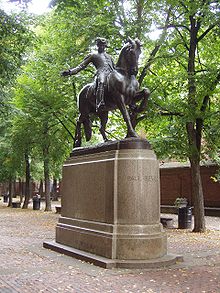 The equestrian statue of Paul Revere in North End, Boston by Cyrus Dallin was unveiled on September 22, 1940. The equestrian statue of Paul Revere in North End, Boston by Cyrus Dallin was unveiled on September 22, 1940.Revere was captured and questioned by the British soldiers at gunpoint. He told them of the army's movement from Boston, and that British army troops would be in some danger if they approached Lexington, because of the large number of hostile militia gathered there. He and other captives taken by the patrol were still escorted east toward Lexington, until about a half mile from Lexington they heard a gunshot. The British major demanded Revere explain the gunfire, and Revere replied it was a signal to "alarm the country". As the group drew closer to Lexington, the town bell began to clang rapidly, upon which one of the captives proclaimed to the British soldiers "The bell's a'ringing! The town's alarmed, and you're all dead men!" The British soldiers gathered and decided not to press further towards Lexington but instead to free the prisoners and head back to warn their commanders. The British confiscated Revere's horse and rode off to warn the approaching army column. Revere walked to Rev. Jonas Clarke's house, where Hancock and Adams were staying. As the battle on Lexington Green unfolded, Revere assisted Hancock and his family in their escape from Lexington, helping to carry a trunk of Hancock's papers. The ride of the three men triggered a flexible system of "alarm and muster" that had been carefully developed months before, in reaction to the colonists' impotent response to the Powder Alarm of September 1774. This system was an improved version of an old network of widespread notification and fast deployment of local militia forces in times of emergency. The colonists had periodically used this system all the way back to the early years of Indian wars in the colony, before it fell into disuse in the French and Indian War. In addition to other express riders delivering messages, bells, drums, alarm guns, bonfires, and a trumpet were used for rapid communication from town to town, notifying the rebels in dozens of eastern Massachusetts villages that they should muster their militias because the regulars in numbers greater than 500 were leaving Boston with possible hostile intentions. This system was so effective that people in towns 25 miles (40 km) from Boston were aware of the army's movements while they were still unloading boats in Cambridge. Unlike in the Powder Alarm, the alarm raised by the three riders successfully allowed the militia to confront the British troops in Concord, and then harry them all the way back to Boston. Henry Wadsworth Longfellow popularized Paul Revere in The Midnight Ride of Paul Revere, a poem first published in 1863 as part of Tales of a Wayside Inn.
 Samoa (/səˈmoʊə/), officially the Independent State of Samoa (Samoan: Malo Saʻoloto Tutoʻatasi o Sāmoa; Samoan: Sāmoa, IPA: [ˈsaːmoa]) and, until 4 July 1997, known as Western Samoa, is a country consisting of two main islands, Savai'i and Upolu, and four smaller islands. The capital city is Apia. The Lapita people discovered and settled the Samoan Islands around 3,500 years ago. They developed a unique Samoan language and Samoan cultural identity. Samoa (/səˈmoʊə/), officially the Independent State of Samoa (Samoan: Malo Saʻoloto Tutoʻatasi o Sāmoa; Samoan: Sāmoa, IPA: [ˈsaːmoa]) and, until 4 July 1997, known as Western Samoa, is a country consisting of two main islands, Savai'i and Upolu, and four smaller islands. The capital city is Apia. The Lapita people discovered and settled the Samoan Islands around 3,500 years ago. They developed a unique Samoan language and Samoan cultural identity.
Samoa is a unitary parliamentary democracy with eleven administrative divisions. The country is a member of the Commonwealth of Nations. Western Samoa was admitted to the United Nations on 15 December 1976. The entire island group, which includes American Samoa, was called "Navigator Islands" by European explorers before the 20th century because of the Samoans' seafaring skills.  .svg/250px-Samoa_on_the_globe_(Polynesia_centered).svg.png) After repeated efforts by the Samoan independence movement, the New Zealand Western Samoa Act 1961 of 24 November 1961 granted Samoa independence, effective on 1 January 1962, upon which the Trusteeship Agreement terminated. Samoa also signed a friendship treaty with New Zealand. Samoa, the first small-island country in the Pacific to become independent, joined the Commonwealth of Nations on 28 August 1970. While independence was achieved at the beginning of January, Samoa annually celebrates 1 June as its independence day. After repeated efforts by the Samoan independence movement, the New Zealand Western Samoa Act 1961 of 24 November 1961 granted Samoa independence, effective on 1 January 1962, upon which the Trusteeship Agreement terminated. Samoa also signed a friendship treaty with New Zealand. Samoa, the first small-island country in the Pacific to become independent, joined the Commonwealth of Nations on 28 August 1970. While independence was achieved at the beginning of January, Samoa annually celebrates 1 June as its independence day.
Travel writer Paul Theroux noted marked differences between the societies in Western Samoa and American Samoa in 1992. In 2002, New Zealand's prime minister Helen Clark formally apologised for New Zealand's role in the events of 1918 and 1929. Early Samoa New Zealand scientists have dated remains in Samoa to about 2900 years ago. These were found at a Lapita site at Mulifanua and the findings were published in 1974. The origins of the Samoans are closely studied in modern research about Polynesia in various scientific disciplines such as genetics, linguistics and anthropology. Scientific research is ongoing, although a number of different theories exist; including one proposing that the Samoans originated from Austronesian predecessors during the terminal eastward Lapita expansion period from Southeast Asia and Melanesia between 2,500 and 1,500 BCE. Intimate sociocultural and genetic ties were maintained between Samoa, Fiji, and Tonga, and the archaeological record supports oral tradition and native genealogies that indicate inter-island voyaging and intermarriage between pre-colonial Samoans, Fijians, and Tongans. Notable figures in Samoan history included the Tui Manu'a line and Queen Salamasina (15th century). Nafanua was a famous woman warrior who was deified in ancient Samoan religion. Contact with Europeans began in the early 18th century. Jacob Roggeveen, a Dutchman, was the first known European to sight the Samoan islands in 1722. This visit was followed by French explorer Louis-Antoine de Bougainville, who named them the Navigator Islands in 1768. Contact was limited before the 1830s, which is when English missionaries and traders began arriving.
|
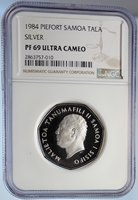
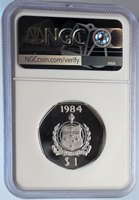
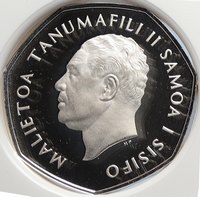
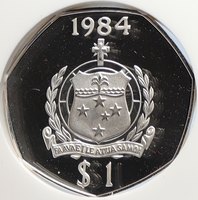
 Malietoa Tanumafili II (4 January 1913 - 11 May 2007), addressed Susuga Malietoa Tanumafili II, was the Malietoa, the title of one of Samoa's four paramount chiefs, and the head of state, or O le Ao o le Malo, a position that he held for life, of Samoa from 1962 to 2007. He was co-head of state in 1962 with the tama-a-'aiga Tupua Tamasese Mea'ole and became the sole head of state on 15 April 1963 upon the death of his counterpart. At the time of his death, he was the oldest national leader in the world, and was also the last incumbent president-for-life in the world.
Malietoa Tanumafili II (4 January 1913 - 11 May 2007), addressed Susuga Malietoa Tanumafili II, was the Malietoa, the title of one of Samoa's four paramount chiefs, and the head of state, or O le Ao o le Malo, a position that he held for life, of Samoa from 1962 to 2007. He was co-head of state in 1962 with the tama-a-'aiga Tupua Tamasese Mea'ole and became the sole head of state on 15 April 1963 upon the death of his counterpart. At the time of his death, he was the oldest national leader in the world, and was also the last incumbent president-for-life in the world. 
 The equestrian statue of Paul Revere in North End, Boston by Cyrus Dallin was unveiled on September 22, 1940.
The equestrian statue of Paul Revere in North End, Boston by Cyrus Dallin was unveiled on September 22, 1940. Samoa (/səˈmoʊə/), officially the Independent State of Samoa (Samoan: Malo Saʻoloto Tutoʻatasi o Sāmoa; Samoan: Sāmoa, IPA: [ˈsaːmoa]) and, until 4 July 1997, known as Western Samoa, is a country consisting of two main islands, Savai'i and Upolu, and four smaller islands. The capital city is Apia. The Lapita people discovered and settled the Samoan Islands around 3,500 years ago. They developed a unique Samoan language and Samoan cultural identity.
Samoa (/səˈmoʊə/), officially the Independent State of Samoa (Samoan: Malo Saʻoloto Tutoʻatasi o Sāmoa; Samoan: Sāmoa, IPA: [ˈsaːmoa]) and, until 4 July 1997, known as Western Samoa, is a country consisting of two main islands, Savai'i and Upolu, and four smaller islands. The capital city is Apia. The Lapita people discovered and settled the Samoan Islands around 3,500 years ago. They developed a unique Samoan language and Samoan cultural identity. 
.svg/250px-Samoa_on_the_globe_(Polynesia_centered).svg.png) After repeated efforts by the Samoan independence movement, the New Zealand Western Samoa Act 1961 of 24 November 1961 granted Samoa independence, effective on 1 January 1962, upon which the Trusteeship Agreement terminated. Samoa also signed a friendship treaty with New Zealand. Samoa, the first small-island country in the Pacific to become independent, joined the Commonwealth of Nations on 28 August 1970. While independence was achieved at the beginning of January, Samoa annually celebrates 1 June as its independence day.
After repeated efforts by the Samoan independence movement, the New Zealand Western Samoa Act 1961 of 24 November 1961 granted Samoa independence, effective on 1 January 1962, upon which the Trusteeship Agreement terminated. Samoa also signed a friendship treaty with New Zealand. Samoa, the first small-island country in the Pacific to become independent, joined the Commonwealth of Nations on 28 August 1970. While independence was achieved at the beginning of January, Samoa annually celebrates 1 June as its independence day.
